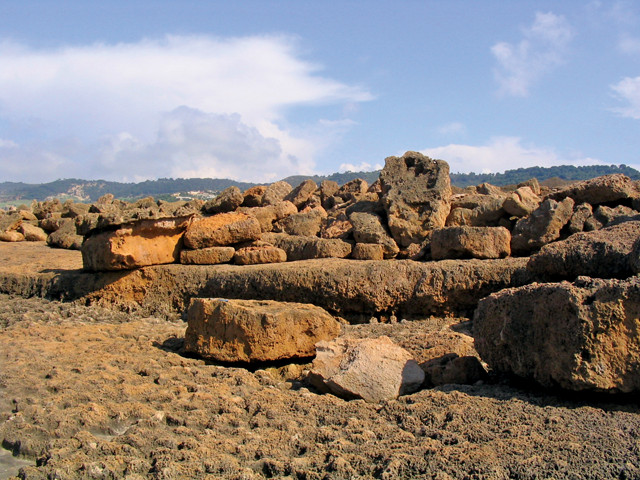
by Mary Caperton Morton Tuesday, January 9, 2018

Large, out-of-place boulders found inland, like these blocks along Algeria's Tipaza Coast, are often taken as evidence of past tsunamis. Credit: C. Morhange.
Tsunamis are one of the most destructive natural hazards on Earth, sometimes even upstaging the major earthquakes that send the waves surging across entire ocean basins. Knowing when, where and how severely tsunamis have struck coastlines in the past is valuable for countries trying to prepare for the impacts of future tsunamis. But distinguishing tsunami deposits in geologic paleorecords from deposits left by more common storm waves is notoriously difficult. Researchers recently highlighted this challenge by taking a hard look at tsunami- and storm-wave records around the Mediterranean Sea over the last 4,500 years. The findings may serve as a cautionary tale for scientists interpreting tsunami records elsewhere in the world.
Storms, and the waves they produce, are common in large bodies of water like the Mediterranean, typically occurring several times each year. On the other hand, localized tsunamis generally occur every few tens to hundreds of years while basinwide tsunamis happen on the order of every few hundred to thousands of years. Given the relative rarity of strong tsunamis, paleostratigraphic studies that rely on coastal sediment cores tend to overreport the incidence of tsunamis, while underreporting storm events, says Nick Marriner, a geomorphologist with the French National Center for Scientific Research and lead author of a new study in Science Advances.
The difficulty in distinguishing tsunamis from storms in cores arises because “the processes of sediment transport in storms and tsunamis can result in similar sedimentary features observed in respective deposits,” says Robert Weiss, a geologist at Virginia Tech who was not involved in the new study. Those features are “so similar that it may be impossible to tell them apart in the geologic record.”
Typically, studies draw upon sandy marine deposits and other clues found far inland, such as large boulders, as evidence of past tsunamis. Deepwater microorganisms transported onto land may also be evidence of tsunami waves that ran up far ashore, since storm waves tend to act more locally. But in many situations — especially when the position of a particular deposit relative to where the shoreline was when the deposit was laid down is unclear — attributing evidence to a tsunami is tricky. “To expect that tsunami and storm deposits look significantly different is just not correct,” Weiss says. “Anybody who says they can tell them apart just by looking at them is overconfident, in my opinion.”
To assess the accuracy of tsunami records around the Mediterranean, Marriner and his colleagues built a comprehensive database of tsunami and storm events identified in sediment cores over the past 4,500 years. “The idea was to be able to compare and contrast the tsunami record with storm and paleoclimate records, as well as to get a clearer picture of tsunami variability for the Mediterranean,” Marriner says. “This way we can take several different lines of evidence — sedimentological, paleontological, archaeological and historical — into account before we say whether a horizon was deposited by a tsunami or a storm surge.”
The team looked at 135 incidents in eight Mediterranean countries that have been pegged by previous studies as evidence for past tsunamis. “When you look at the [scientific] literature, people are always finding tsunamis, but they’re rarely reporting storms. It seems like people overlook the storm-wave hypothesis too quickly in favor of the more exciting tsunami finding,” Marriner says. “We found the dates for the [reported] tsunamis clustered every 1,500 years — at about 200, 1,600 and 3,100 years ago,” he says, which matched known 1,500-year cycles of climatic cooling and heightened storm activity in the Mediterranean and North Atlantic. “This suggests most of the geological evidence is related to periods of severe storms, rather than tsunamis.”
Tsunamis are a known hazard in the Mediterranean, where seismic activity is common. Episodes of volcanism can also set off deadly tsunamis — such was the case when a catastrophic eruption of the Santorini Volcano 3,500 years ago set off the Mediterranean’s largest-known tsunami event, devastating Crete and potentially kick-starting the legend of the lost city of Atlantis.
“We are not trying to downgrade the danger of tsunamis in the Mediterranean in any way,” Marriner says. “Researchers just need to be more aware that storms were key in shaping Mediterranean coastlines over the past few thousand years, and take into account both types of hazards.”
Whether tsunamis have been over-reported in other ocean basins remains to be seen, Marriner says. “It will be interesting to take a similar database approach and apply it to other regions.
© 2008-2021. All rights reserved. Any copying, redistribution or retransmission of any of the contents of this service without the expressed written permission of the American Geosciences Institute is expressly prohibited. Click here for all copyright requests.